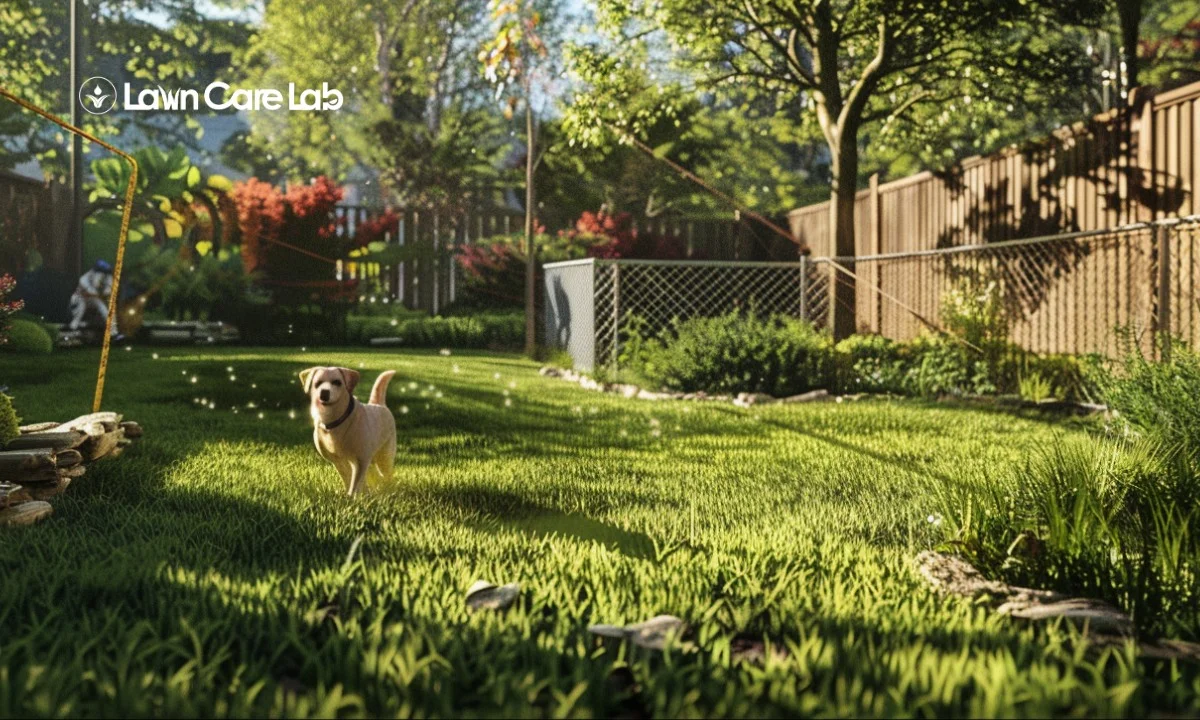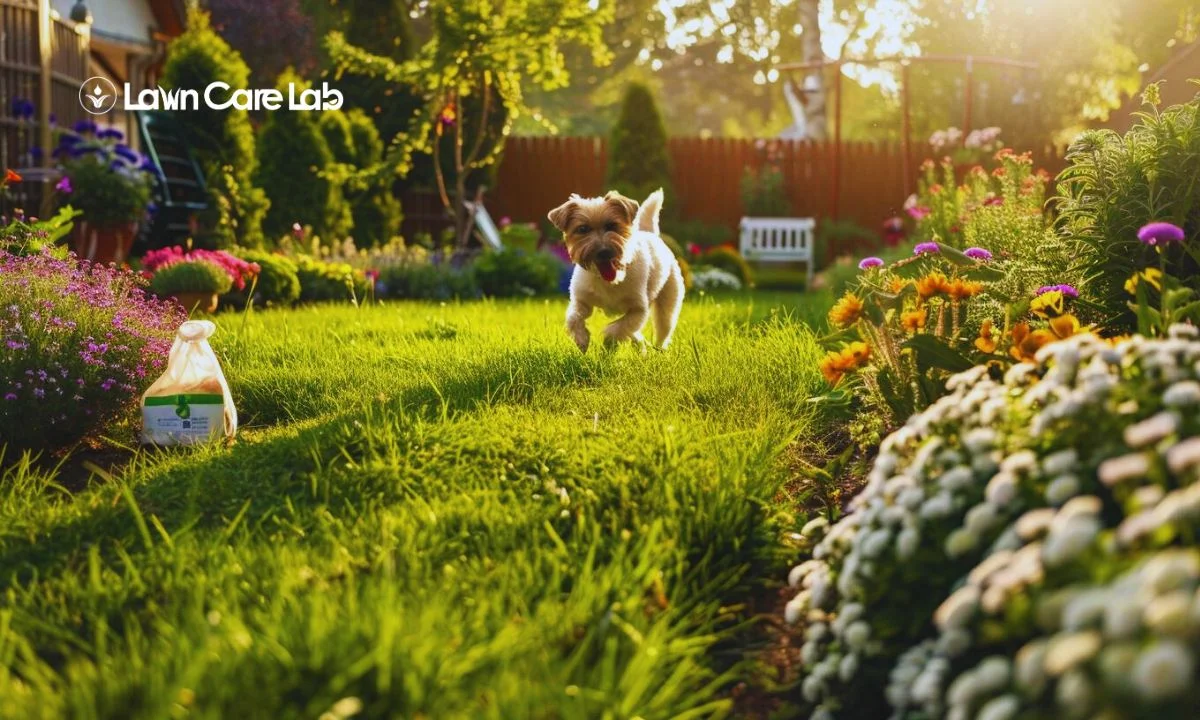As a dog owner, maintaining a lush, vibrant lawn can often seem like a battle against nature. Dogs, as much as we love them, can inadvertently cause significant wear and tear on our grassy spaces. From urine spots that burn the grass to paths worn from constant play, the challenges are real but not insurmountable.
This article provides practical strategies to restore and protect lawn damage from Dogs.
Learn how to identify signs of lawn distress, implement effective repairs, and choose robust grass types suited for pet-heavy yards. With the right approach, you can enjoy a beautiful lawn while accommodating your furry friends.
Join us as we explore how to balance the joy of pet ownership with the pride of a well-kept yard.
Table of Contents
Recognizing and Understanding Lawn Damage
To effectively manage lawn health, it’s crucial to recognize signs of damage. For example, if you notice areas turning yellow, spots without grass or uneven patches, these could be indicators of underlying issues.
Specifically, if your dog often visits certain parts of your lawn, it might be causing these damages. To address this, you might consider using pet-friendly lawn repair products or establishing a designated area for your pet to help protect your grass.
This approach not only keeps your lawn looking good but also ensures it remains healthy.
How Dogs Affect Lawn Health
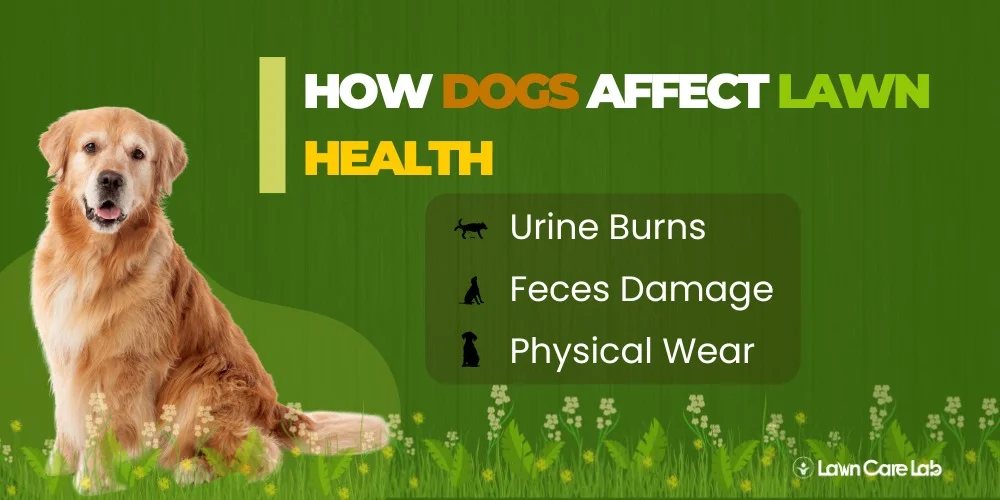
Dogs can impact your lawn health in several ways. Their urine can create yellow spots due to high nitrogen levels, possibly leading to grass burns if not promptly washed away. Dog feces, if left uncleaned, can also damage the turf. Moreover, dogs often dig holes and wear out the grass through their vigorous activities, leading to bare patches and uneven lawns.
To mitigate these effects, immediate action, such as watering the areas where your dog urinates, can help dilute the nitrogen, reducing damage to the grass. Encouraging your dog to use designated or less visible areas for elimination can further protect your lawn.
Additionally, regular lawn aeration is crucial as it alleviates soil compaction, allowing grassroots better access to nutrients and promoting a healthier, more resilient lawn. These preventive measures ensure your lawn remains lush and vibrant, even with an active dog.
Signs of Lawn Damage from Dogs
To maintain a healthy lawn, it’s vital to recognize signs of damage:
- Yellow Patches: These are usually irregularly shaped and indicate urine burn. Dog urine contains high nitrogen levels, which can kill grass, leaving yellow spots.
- Trampled Grass: Areas of grass that look flattened or worn suggest frequent use by your dog. These are common paths where your dog walks or plays.
- Bare Spots: If you see areas with no grass at all, your dog might be digging there.
- Uneven Growth: When parts of your lawn are thick, and others are thin, it could be because your dog prefers certain areas more than others.
By being proactive and attentive, you can enjoy the benefits of having a dog while maintaining a lush, green lawn.
Immediate Actions to Protect Your Lawn
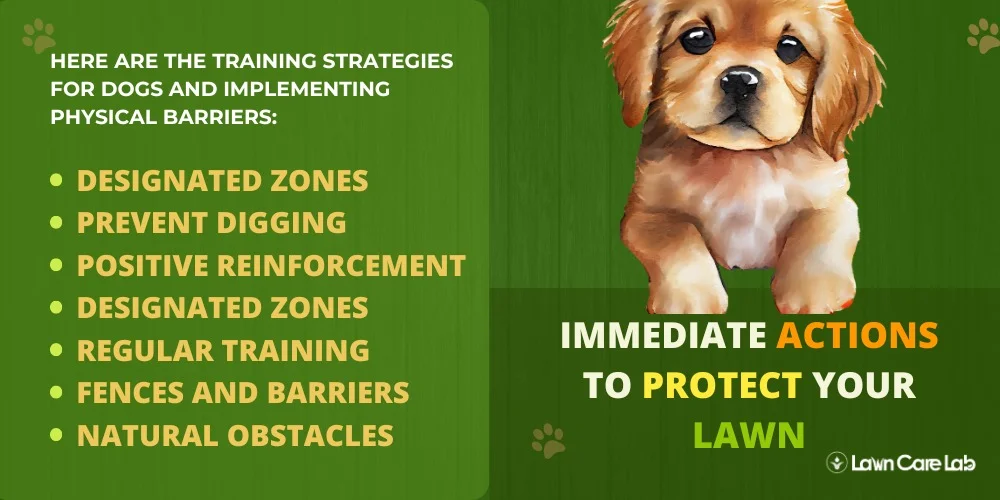
Train your dog to use designated areas for their needs. Teach them where to urinate and play, discourage digging, and install barriers to protect sensitive areas.
Training Strategies for Dogs
Teach your dog where to urinate and play, stop them from digging, and reinforce good behavior. This strengthens your bond with your dog and keeps your lawn in good shape.
- Set Specific Zones: Pick a part of your yard for your dog to use as a bathroom and another area for play. Consistently guide your dog to these areas until they learn these are their spaces.
- Prevent Digging: When your dog starts to dig, immediately engage them with a toy or a specific command like ‘no dig.’ Over time, your dog will learn that digging isn’t allowed.
- Encourage Positive Behavior: Always use positive reinforcement. For instance, give your dog a treat or verbal praise when they use the correct area for elimination or when they refrain from digging.
- Maintain Regular Training: Keep a regular training schedule. Daily practice helps reinforce what you’ve taught your dog, ensuring they remember and adhere to the rules.
Implementing Physical Barriers
Install fences or plant beds to protect your grass from dog damage.
- Fences and Barriers: Installing fences or creating plant beds can help protect sensitive areas of your lawn by limiting your dog’s access.
- Use of Natural Obstacles: Strategically placed plant beds can act as natural barriers, protecting high-traffic areas of your lawn and preventing damage from dog activities.
Together, these training strategies and physical barriers play a pivotal role in maintaining the health and aesthetics of your lawn while also setting clear boundaries for your pets.
Choosing the Best Grass and Long-Term Care
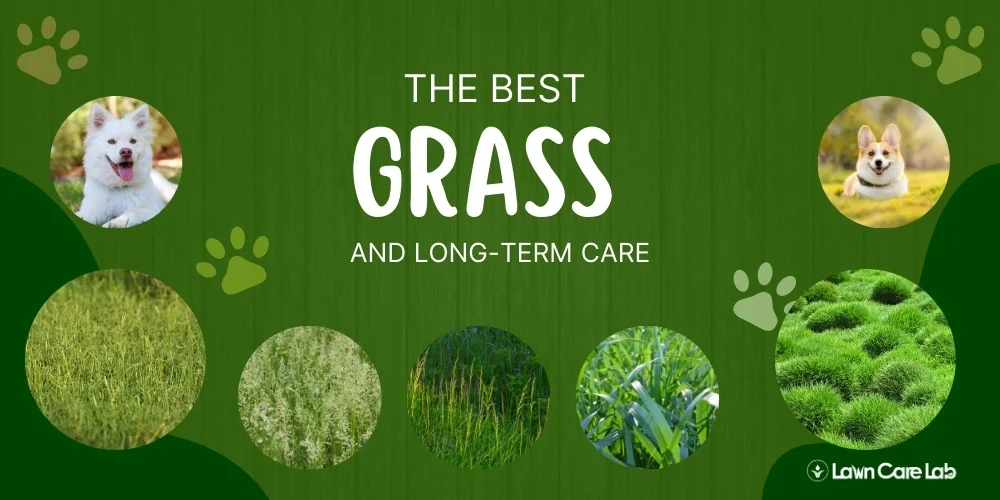
Choose durable grass like Bermuda or Zoysia that can handle your dog’s activity for a healthy lawn. Regular maintenance like watering, mowing, and fertilizing is crucial to sustain a green and vibrant lawn.
Selecting Durable Grass Types
When choosing grass types for lawns frequented by dogs, Bermuda grass and Kentucky Bluegrass are top picks. They’re both highly resilient and can handle lots of activity.
- Bermuda Grass: This grass is very tough and quickly heals from wear and tear. It’s ideal for sunny areas and grows best in warm climates.
- Kentucky Bluegrass: This grass thrives in cooler climates and has a lush, dark green appearance. It’s good for areas with moderate activity and fills in damaged spots well.
- Perennial Ryegrass: Known for its durability, this cool-season grass tolerates high traffic and heals quickly from wear.
- Tall Fescue: With a strong root system, this grass stands up well in busy areas and is more drought and heat-resistant than other cool-season types.
These grasses aren’t just tough; they also maintain a visually appealing lawn despite the challenges posed by pet activity. For example, Bermuda grass, besides being durable, keeps a dense and vibrant look even in full sun, making it both practical and attractive for sunny gardens.
Maintenance Tips for a Robust Lawn
Maintaining a robust lawn, especially with dogs around, requires careful and consistent upkeep. Here are some detailed tips to help you ensure your lawn stays healthy:
- Water Wisely: It’s best to water your lawn once a week, giving it an inch of water. This encourages deep root growth and strengthens the grass against drought and wear.
- Mowing Strategy: Mow your grass in the highest setting. Taller grass promotes deeper root growth, protects soil from sun exposure, and prevents weed growth and moisture loss.
- Fertilization Schedule: Fertilize your lawn twice a year with a balanced fertilizer for optimal recovery and winter preparation.
- Choose Tough Grass Types: For high-traffic areas where dogs are frequently present, choose tough grass types like tall fescue or perennial ryegrass.
- Prompt Cleanup: Dilute dog urine with water immediately to minimize grass damage. Remove feces daily for hygiene.
- Regular Monitoring and Maintenance: Watch for signs of wear or damage like thinning grass or bare patches. Fix them quickly by reseeding or applying spot treatments to keep your lawn lush and green.
Repair Techniques for Dog-Damaged Lawns
To repair a dog-damaged lawn efficiently, apply this structured approach:
- Assess Damage Severity: Check your lawn for damage by examining grass color, root health, and bare patches. Then, decide on the best repair strategy.
- Choose Repair Method:
- Light Damage: Simply reseed the affected areas to reintroduce uniformity.
- Extensive Damage: Aerate the soil to improve its structure, enhancing water and nutrient absorption. Follow with reseeding or applying lawn repair products tailored to your grass type and climate.
- Restoration:
- Reseeding/Resodding: Use new seeds for minor spots or sod for larger areas.
- Aeration: Make small holes in the soil to help the lawn breathe and grow.
- Apply Repair Products: Use products like Scotts EZ Seed or Miracle-Gro Lawn Food for targeted recovery.
- Maintenance: Water regularly and minimize foot traffic in recovering areas to promote growth and protect new grass.
By systematically assessing and addressing the damage and applying the right treatments, you can restore your lawn’s health and prepare it to endure future wear.
Preventive Strategies to Sustain Your Lawn
To sustain a healthy lawn and minimize damage from dogs, it’s vital to adopt a proactive approach that includes regular maintenance and the use of specialized products. Here’s a structured guide:
Routine Care Practices
To keep your lawn healthy, it’s crucial to follow certain care practices. These include watering often, mowing regularly, fertilizing on time, and quickly cleaning up after your dogs.
Here’s how you can protect your lawn from damage caused by dogs:
- Watering: Keep your lawn hydrated to dilute and minimize the impact of dog urine. Regular watering helps the grass stay resilient and lush.
- Mowing: Maintain a longer grass length to protect the soil and reduce the effects of pet urine. Avoid cutting the grass too short as this can increase vulnerability.
- Fertilization: Use appropriate fertilizers to strengthen your lawn, making it more robust against wear and damage. Select a fertilizer tailored to your specific grass type.
- Cleanup: Promptly remove dog waste to prevent the lawn from getting damaged. This helps in maintaining both the aesthetics and health of the grass.
Regularly check your lawn for any signs of distress. Catching issues early can make fixing them easier. Remember, taking proactive steps is key to maintaining a vibrant and healthy lawn.
Advanced Products to Deter Dogs
Advanced products like dog repellents, lawn protectants, and specialized dog toilets can protect your lawn from damage caused by dogs.
Let’s take a closer look at each option:
- Dog Repellents: Use products like sprays or granules designed to keep dogs off the lawn. These repellents are safe and effective, helping to prevent dogs from damaging specific areas.
- Lawn Protectants: Apply products that mitigate the effects of dog urine, such as those that neutralize nitrogen, which is a common cause of yellow spots.
- Specialized Dog Toilets: Install a designated area like ‘Porch Potty’ for dogs to maintain cleanliness and sanitary conditions.
Each of these products plays a crucial role in maintaining the appearance and health of your lawn, making them worthwhile investments for dog owners.
Conclusion
Restoring your lawn from dog damage is a long-term effort, not an overnight fix. Considering that over 63 million households in the U.S. have dogs, you’re definitely not tackling this issue alone.
To effectively mend your lawn, start by identifying the damaged areas quickly. Choose tough types of grass that can withstand some wear and tear. Implement effective repair strategies and consider preventative measures to keep the lawn healthy.
Over time, with consistent care, your lawn will become lush and vibrant again, making it a great place for both you and your dog to enjoy.
Frequently Asked Questions
What Are Some Pet-Friendly Alternatives to a Grass Lawn?
How Can I Train My Dog to Avoid Certain Areas of the Lawn?
Can Certain Dog Breeds Cause More Damage to Lawns Than Others?
Are There Specific Dog Foods That Reduce Urine Damage to the Grass?
Are There Any Lawn-Safe Toys or Activities That Can Distract My Dog From Digging?
It’s crucial to be consistent with this training. Every time your dog goes near the restricted area, repeat the guidance and reward process. Over time, your dog will associate staying away from these spots with getting rewards.
For example, if you want to keep your dog away from a newly seeded patch of grass, you could place some visual markers like small flags around the area. Each time your dog nears the flags, lead them away, and then give them a treat or their favorite toy when they move to a safer spot.
- How to Create a Lawn Care Schedule for Southern Climates - October 30, 2024
- How to Use Compost Tea to Boost Lawn Growth and Soil Health - October 23, 2024
- The Best Grasses for Saltwater-Exposed Lawns: Coastal Lawn Care - October 17, 2024

